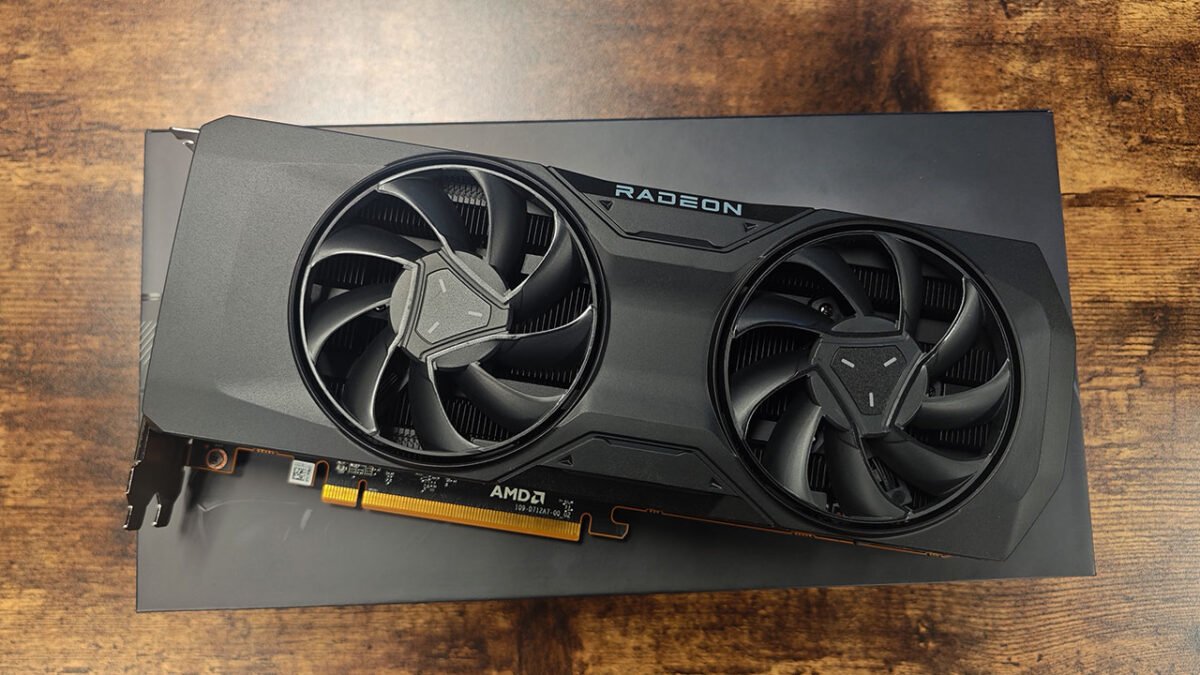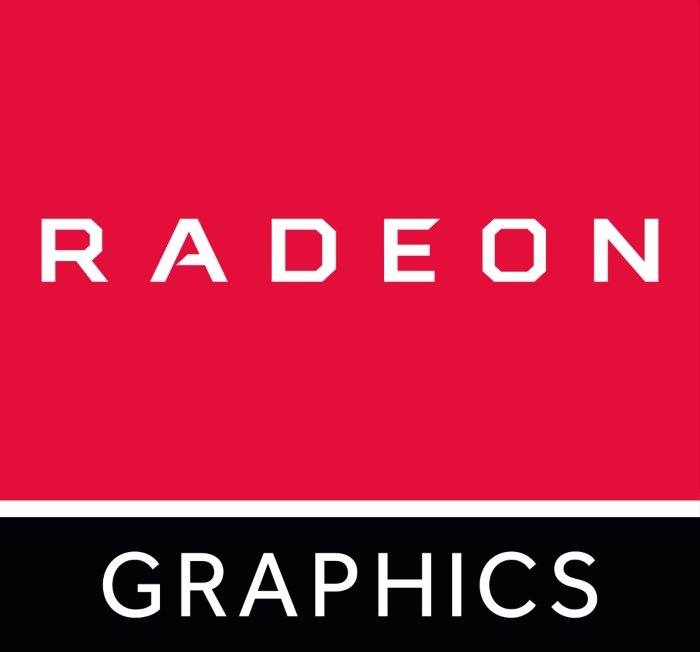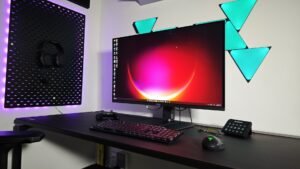The GPU market is getting very interesting, and AMD has just groped the gauntlet at NVIDIA’s feet with the announcement of the AMD Radeon RX 7800 XT GPU at Gamescom. This new GPU is an intriguing addition to AMD’s arsenal, filling a noticeable gap in the lineup based on the RDNA 3 architecture. Priced at $499 and set for a September 6, 2023, release, this card aims to go head-to-head with NVIDIA’s GeForce RTX 4060 Ti and RTX 4070, and based on the specs, AMD seems to have pulled off a rather compelling proposition.
Design and Specs
Out of the box with its reference card, AMD has managed to keep the sleek premium style that we saw on the Radeon RX 7600, the Radeon RX 7900 XTX and the Radeon RX 7900 XT. The dark black case and back panel with small red accents make a statement but are subtle thanks to the lack of RGB seen on its bigger brothers. The two-slot GPU also looks fantastic inside the computer while not taking up as much space as some of the other cards in the range.

Under the hood, the AMD Radeon RX 7800 XT GPU is based on the Navi 32 GPU and has 60 processing cores, placing it between the budget-friendly Radeon RX 7600 (with 32 processing cores) and the behemoth Radeon RX 7900 XTX (with 96 processing cores). Those 60 cores translate to 3,840 stream processors and the same number of ray tracing cores.
But what really stands out are the 120 AI accelerator matrix cores, AMD’s answer to NVIDIA’s Tensor cores. While these AI accelerators have been relatively dormant in the AMD ecosystem, they could soon play a pivotal role in an updated version of FSR that could mean big FPS gains, especially in ray tracing workflows. However, since this is currently unavailable, we can only review the card as it is, so we can only speculate on its impact, at least until it is fully released.
Memory-wise, the RX 7800 XT offers some impressive numbers, especially for its mid-range price point, with its generous 16GB of GDDR6 VRAM clocked at an impressive 19.5 Gb/s with a bandwidth of 624 Gb/s. This is connected via a 256-bit interface for a total effective bandwidth of 2708.4 GB/s. To put this into perspective, NVIDIA’s RTX 4070 offers only 12GB of memory connected to a narrower 192-bit interface. AMD clearly wants to offer a strong alternative for those who find NVIDIA’s memory systems lacking while maintaining a price point that’s significantly more affordable than the RTX 4070 and on par with the RTX 4060 Ti 16GB.

Thanks to AMD’s second-generation Infinity Cache, gamers and content creators can expect fantastic performance thanks to the way data is delivered to the GPU. The mix of Inifty cache and L2 cache is said to ensure that everything moves efficiently, providing incredibly fast data access and increased bandwidth while keeping things as efficient as possible.
“Memory-wise, the RX 7800 XT offers some impressive numbers, especially for its mid-range price point…”
Even though it is physically much smaller than some of the bigger cards in the RDNA 3 range, the Radeon RX 7800 XT has all the ports you need for a solid multi-monitor setup, with the ability to connect up to four displays in total. It comes equipped with a single HDMI 2.1a port along with three DisplayPort 2.1 ports, complete with UHBR13.5 (Ultra High Bit Rate) support for that extra layer of visual fidelity. The card is also built to support high-end 1440P gaming, so you should have no problem pushing an extra display even if you want to play games or stream.
Utilizing dual 8-pin connections, the Radeon RX 7800 XT draws a TBP of 263W, with AMD recommending at least a 700W PSU to drive the card. This is compared to the 245W of its little brother, the Radeon RX 7700 XT and only 13 more Watts compared to the last generation Radeon RX 6800.

Gaming Benchmarks
With the specs and design out of the way, it is time to drop it in our test bench and put it through its paces. Much like we did for the Radeon RX 7700 XT, we slotted the Radeon RX 7800 XT into our current test rig, which features an Intel Core i9-13900K CPU, 32 GB DDR 4 RAM, 1TB WD Black m.2 SSD, a Cooler Master Hyper 622 Halo White CPU cooler, all running on an NZXT N7 Z690 Motherboard. We wanted to keep the system comparable to past tests we have done on the NVIDIA GeForce RTX 4070 and GeForce RTX 4060 TI to best compare all cards in similar price brackets.
Out of the gate, the AMD Radeon RX 7800 XT GPU delivers some impressive numbers across the board, with it slightly edging out NVIDIA’s GeForce RTX 4070 in some tests and landing a few frames a second behind in others. This is true for 1080P and 1440P gaming across a range of titles, with the numbers falling close to the official benchmarks by AMD’s own comparative data released during its gamescom announcement.
| 1080P Benchmarks | Radeon 7900 XTX | GeForce RTX 4070 | RTX 4060 Ti | RX 7700XT | RX 7800 XT |
|---|---|---|---|---|---|
| Cyberpunk 2077 | 155 | 146.52 | 102.21 | 109.62 | 139.81 |
| Cyberpunk 2077 RT | 75 | 59.32 | 42.4 | 30.02 | 40.2 |
| Shadow of the Tomb Raider | 247 | 216 | 200 | 138 | 141 |
| Assassin’s Creed Valhalla | 209 | 148 | 121 | 117 | 137 |
| Call of Duty: Modern Warfare 2 | 236 | 145.1 | 121 | 172 | 195 |
Looking at the 1080P gaming benchmarks, the Radeon RX 7800 XT manages to blow well past the RTX 4060TI, coming close to the RTX 4070, especially in games like Assassin’s Creed Valhalla and Cyberpunk 2077, with it managing a solid lead of 195 to 145.1 our Call of Duty: Modern Warfare 2 benchmark.
| 1440P Benchmarks | Radeon 7900 XTX | GeForce RTX 4070 | RTX 4060 Ti | RX 7700XT | RX 7800 XT |
|---|---|---|---|---|---|
| Cyberpunk 2077 | 128 | 80 | 63.55 | 87.86 | 104 |
| Cyberpunk 2077 RT | 55 | 36.81 | 27.26 | 22.69 | 25.85 |
| Shadow of the Tomb Raider | 224 | 162 | 132 | 127 | 132 |
| Assassin’s Creed Valhalla | 170 | 113 | 89 | 94 | 109 |
| Call of Duty: Modern Warfare 2 | 171 | 105.5 | 84 | 132 | 147 |
A similar story for when we push things to 1440P, with the Radeon RX 7800 XT holding its own against the more expensive RTX 4070, with the gap even smaller in Assassin’s Creed Valhalla, only losing by 4 FPS. It still manages a win in Call of Duty: Modern Warfare 2, and it even managed to pull ahead in Cyberpunk 2077 without ray tracing, delivering a solid 104 FPS against the 80 we saw from the RTX 4070.
| 4K Benchmarks | Radeon 7900 XTX | GeForce RTX 4070 | RX 7700XT | RX 7800 XT |
|---|---|---|---|---|
| Cyberpunk 2077 | 80.8 | 37.12 | 35 | 51.8 |
| Cyberpunk 2077 RT | 31.3 | 37.14 | 8.89 | 12.17 |
| Shadow of the Tomb Raider | 131 | 84 | 76 | 78 |
| Assassin’s Creed Valhalla | 108 | 67 | 55 | 68 |
| Call of Duty: Modern Warfare 2 | 125 | 63.5 | 78 | 90 |
It’s crucial to note that all of this prowess comes at an MSRP of $499, a full $100 less than NVIDIA’s RTX 4070. This strategic pricing by AMD seems designed to shift the consumer gaze squarely onto the RX 7800 XT as the go-to choice for high-performance, value-driven gaming. In the grand scheme of things, if a cheaper card delivers better performance, the decision becomes somewhat of a no-brainer for the average consumer.
Without ray tracing turned on, the story is similar when we push things to 4K, with the Radeon RX 7800 XT delivering surprisingly good results in games like Cyberpunk 2077, Assassin’s Creed Valhalla, and Call of Duty: Modern Warfare 2. All games, even at 4K, were very playable, all managing well over 30FPS, with only Cyberpunk 2077 sitting at a sub 60FPS. Honestly, I did not expect such a solid showing from a mid-range card, but AMD has managed to deliver some fantastic results.


Sadly, while standard rasterized workflows held their own against NVIDIA’s mid-range, it tells a different story once ray tracing is thrown into the mix. While AMD has made some strides with ray tracing performance, NVIDIA still has the upper hand, thanks to DLSS. While AMD has FSR 3 in the pipeline that is looking to even the playing field, it is sadly not here yet, and that does mean when comparing ray tracing numbers, the RTX 4070 handily wins with games like Cyberpunk 2077. Even though it scores incredibly well across the board when tackling 4K ray tracing, the Radeon RX 7800 XT GPU delivers almost single-digit performance.
While AMD has consistently provided good performance for the money, especially as evidenced by the Radeon RX 7900 XTX and RX 7600, it hasn’t been without its drawbacks. The ray tracing capabilities have been generally considered inferior to NVIDIA’s offerings based on the Ada architecture.
Additionally, AMD has yet to implement any AI frame generation technology comparable to NVIDIA’s DLSS 3, which could be a sticking point for some users. But with the full range of the RDNA 3 family of cards now here, we will hopefully see some improvements on the software side and finally see what FSR 3 brings to the table. While these are not deal breakers for most gamers, it does leave AMD to play catchup if you are in need of ray tracing either in gaming or at work.

Built for Content Creation
When it comes to streaming and media encoding, the AMD Radeon RX 7800 XT has everything you could hope for from a new GPU in 2023. Built on the RDNA 3 architecture, this card offers an impressive suite of features via AMD’s Adrenalin software.
Not just a tool for gamers, Adrenalin has full support for video capture and streaming with a built-in Scene Editor to craft stunning overlays. While the frame rate for capture and streaming is capped at 60 FPS, the quality is nothing short of exceptional. For people that use OBS for streaming, as of version 29.0, it now supports AMD’s Media Engine AV1 Encoder, designed to push the GPU’s power for a cleaner and richer streaming image.
Those looking to push what can be done on the content creation side will be happy to know that both DaVinci Resolve 18.5 and Adobe Premiere Pro are now taking advantage of the Media Engine AV1 Encoder. This encoder allows for recording up to 8K60 video streams, propelling the RX 7700 XT as a compelling tool for professional video editing.
What AMD aims to offer here is an all-in-one package for content creators at every level. The RX 7800 XT, in conjunction with Adrenalin and AMD’s Media Engine, represents a significant stride in AMD’s quest to etch its name in the content creation sphere. AMD has managed to bring out a package that delivers where content creators need most, and that is a fantastic thing to see.

Price and Recommendation
With that all out of the way, and in spite of the ray tracing performance, the AMD RX 7800 XT appears to hit the sweet spot with price and power. Launching at an MSRP of $499, it is perfectly positioned to be one of the best GPUs under $500—a critical price point for a wide range of consumers. Interestingly, it also undercuts its predecessor, the RX 6800 XT, by approximately $200 compared to its launch price. For that price reduction, you’re not only stepping into the next generation with RDNA 3 architecture but also benefitting from faster VRAM and improved power efficiency.
“It’s crucial to note that all of this prowess comes at an MSRP of $499, a full $100 less than NVIDIA’s RTX 4070.”
The full RDNA 3 lineup has proven both powerful as well as aggressively priced to take on the competition. Considering the $499 price and the impressive numbers across the board, the Radeon RX 7800 XT managed to not only compare favourably to the more expensive RTX 4070 but even surpassed it in select tests. While AMD is still falling behind in ray tracing performance, Team Red has a solid offering in the Radeon RX 7800 XT, which stands as the best mid-range GPU you can currently buy.






